Lymphedema and Weight Loss
Living with lymphedema while trying to manage your weight can feel overwhelming, but understanding the connection between lymphedema and weight loss can help you develop effective strategies for both conditions.
Read More
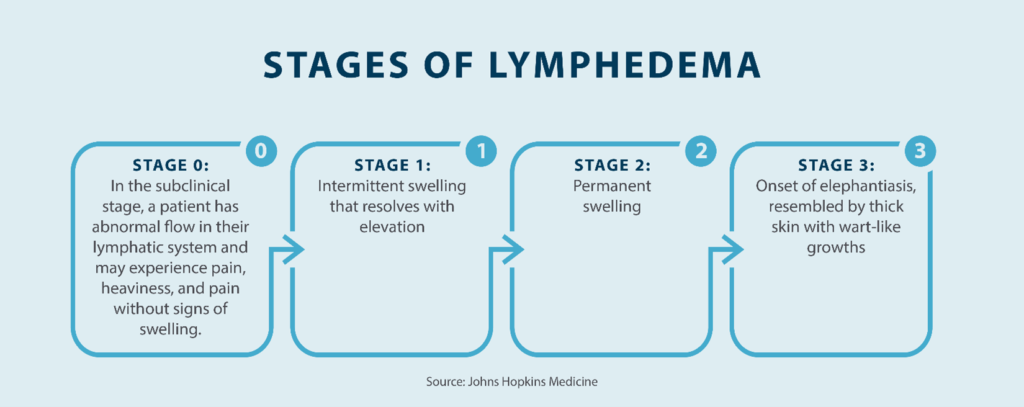
Lymphedema is a progressive disease where an abnormal amount of fluid accumulates in a localized region of the body. This excess fluid typically occurs in an arm or leg, but can also occur anywhere in the body such as the head and neck as well as the chest, abdomen, or genitals. The lymphatic system is often referred to as the main filter for waste products in the body such as toxins, fat, and cancer cells. When the lymphatic system becomes damaged or congested due to lymph node removal or damage to lymph vessels, it can no longer successfully perform its job of filtering toxins and waste from a specific part of the body and this results in swelling, known as lymphedema.
Lymphedema can be painful and uncomfortable and can lead to more serious health conditions if left untreated, such as trouble with mobility, an increased risk of developing a skin infection, and permanent changes in your skin. If you notice your leg or arm is chronically swollen, consult your doctor to get an accurate diagnosis.
In this blog post, we will define lymphedema and outline its causes, symptoms, and treatment options.
Lymphedema refers to an accumulation of fluid or swelling. The lymphatic system that drains this fluid is located just under the skin. Lymph fluid is the part of the lymph system that transports cells that fight infections in the body. Lymphedema is caused by a blockage of the lymphatic vessels, which leads to fluid retention and swelling.
Lymphedema can either be primary or secondary. Primary lymphedema can be inherited or present at birth, while secondary lymphedema is caused by an injury or obstruction of the lymphatic system. Primary lymphedema is rare and affects about 1 in 100,000 individuals, and can develop at any point in your life. Secondary lymphedema is more common, affecting roughly 1 in 1,000 Americans, and is typically the result of damage or injury to the lymph nodes or vessels such as trauma, chronic venous insufficiency, cancer, or cancer treatment.
The lymphatic system is a large network of lymph nodes, vessels, and organs that move lymph fluid throughout the body tissues back to the circulatory system. This network is part of your body’s immune system, and it helps filter and rid the body of toxins and waste. Lymph fluid is made up of fat, water, protein, cellular debris, and lymphocytes that are white blood cells, which help fight bacteria in the blood, and a fluid called chyle, which is found in the intestines.
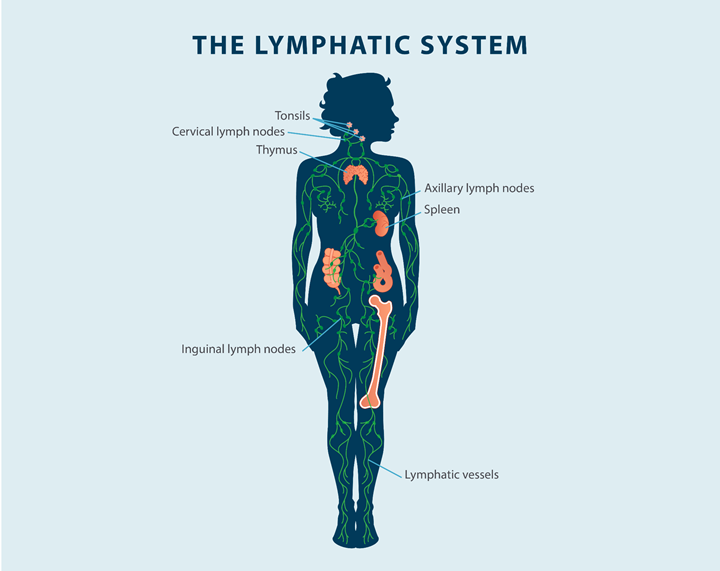
The lymphatic system includes the bone marrow, spleen, lymph nodes, thymus, and lymphatic vessels. The lymphatic vessels spread throughout all the tissues of the body.
Lymph nodes create immune cells, which help the body fight off infections. Lymph nodes also filter the lymph fluid to remove bacteria and cancer cells from the body. If bacteria or cancer cells are found in the lymph fluid, the lymph nodes will create more white blood cells to fight off the infection. Lymph nodes are located in different areas of the body, such as the neck, armpit, abdomen, and groin.
Lymphedema is categorized into four different stages, depending on what your swelling looks like, where it’s occurring, and how it’s progressing.
The four stages of lymphedema are:
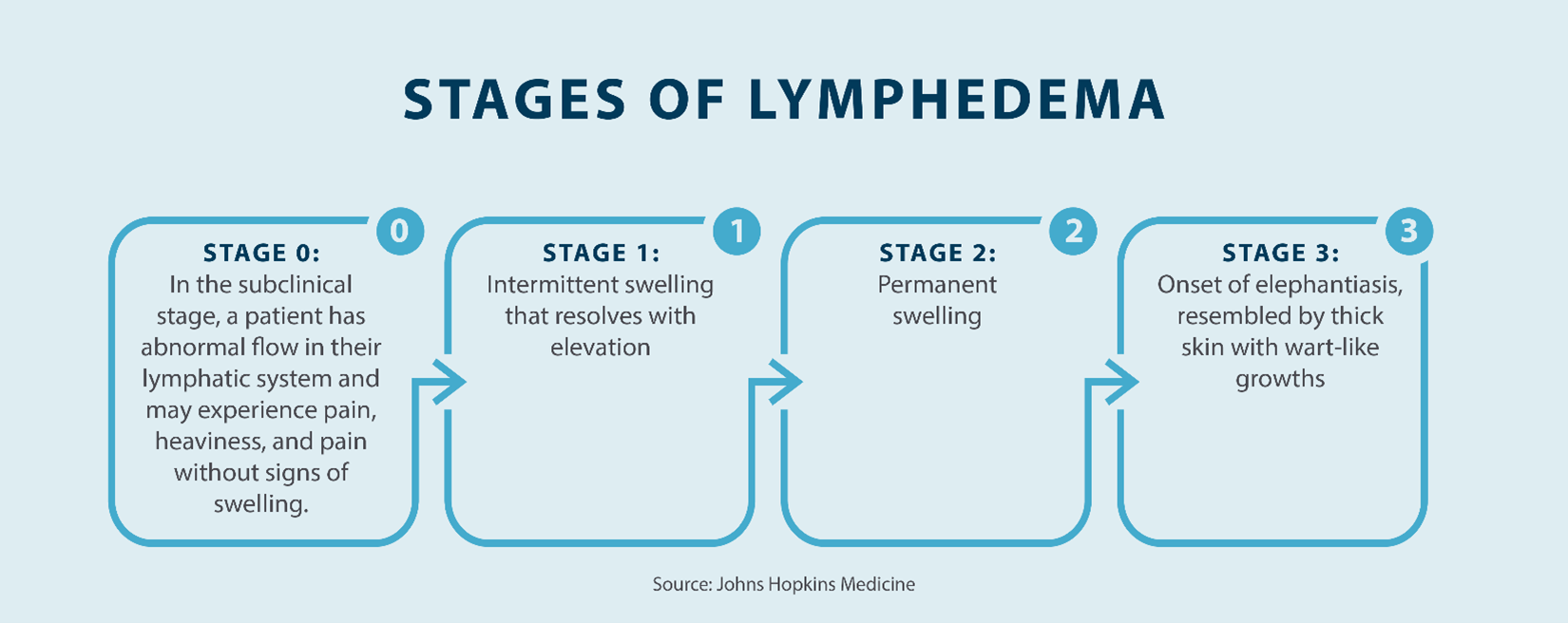
Treating your lymphedema as early as possible is imperative to preventing further symptoms, infections, and skin fibrosis. The key to living with lymphedema is learning ways to manage it, and staying consistent with a treatment routine. This consistency can help you avoid some of the later-stage symptoms that lymphedema can cause.
Understanding the cause of lymphedema can help with your diagnosis and treatment options. Some of the potential causes of lymphedema include:
Lymphedema symptoms can come on suddenly, or they may develop over time. You should keep an eye on your symptoms to see if they change or worsen.
Some of the potential symptoms of lymphedema include:
If you notice any of these symptoms, contact your doctor immediately. Even if the swelling isn’t present at first, it’s possible that your symptoms will progress and lead to more serious health complications.
While lymphedema can’t be fully prevented, there are various steps you can take to reduce your chances of developing it or stop it from escalating, such as:
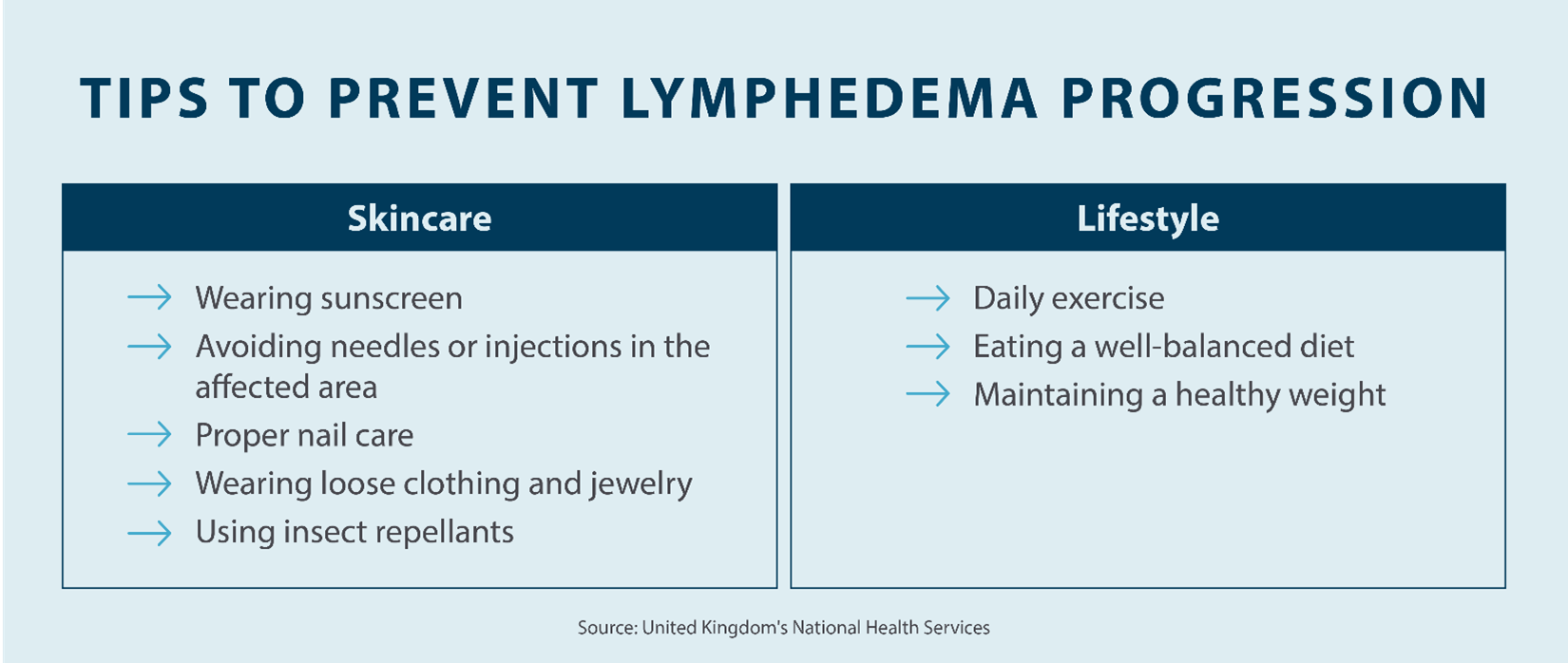
If you suspect you may have lymphedema, it’s important to see a doctor so that you can get a proper diagnosis. Your doctor will have the best idea if what you’re suffering from is lymphedema, and can prescribe the appropriate course of treatment to help you manage symptoms.
Your doctor will likely begin by performing a thorough examination to rule out a more serious condition, such as kidney disease or congestive heart failure. Once you have received a diagnosis of lymphedema, your doctor may order a lymphoscintigraphy to conform the diagnosis. This is a safe assessment, which involved a tiny injection of radioactive dye into your veins to show how the lymph fluids move throughout your body. They may also do an MRI or a CT scan to show where exactly the swelling is taking place. An ultrasound may also be conducted to help find any obstructions that may be causing the swelling.
There are various complications that can result from lymphedema, which is why it’s important to get the swelling treated as soon as symptoms arise.
Some of the potential complications of lymphedema include:
Lymphedema treatment will look different for everyone, depending on what part of your body is affected and how severe your symptoms are. In addition to taking the right steps to prevent your lymphedema from worsening, it’s also important to find the right course of treatment.
A professional lymphedema therapist can provide decongestive therapy. Through decongestive therapy, your therapist will perform a specific type of massage that redirects the flow of fluids away from the swollen region to reduce swelling. A therapist may also provide instructions of how to perform decongestive therapy massage techniques, known as manual lymphatic drainage (MLD), that you can perform at home, along with other forms of at-home treatments, such as:
Daily maintenance is essential to treating your lymphedema and living a healthy and happy life. Lymphedema pumps, also called pneumatic compression devices, fit over extremities that are affected by lymphedema, such as your arms and legs. Then, an air pump fills the device chambers with air which applies a gentle pressure to move excess fluid and relieve symptoms. Using a lymphedema pump is a great way to alleviate symptoms of lymphedema right from your home. Another component of treatment is compression bandages, which help reduce the amount of fluid and prevent it from refilling or building up.
In some cases of lymphedema, your doctor may recommend surgical treatment. Surgical treatment is more common in the latter two stages, but can be performed in earlier stages. if surgery is needed, procedures can include:
To prevent lymphedema from progressing to more severe stages, it’s important to take preventative measures, such as treating and managing symptoms from the start. At Tactile Medical, our at-home lymphedema solutions can help you alleviate discomfort, relieve pain, and improve mobility challenges.
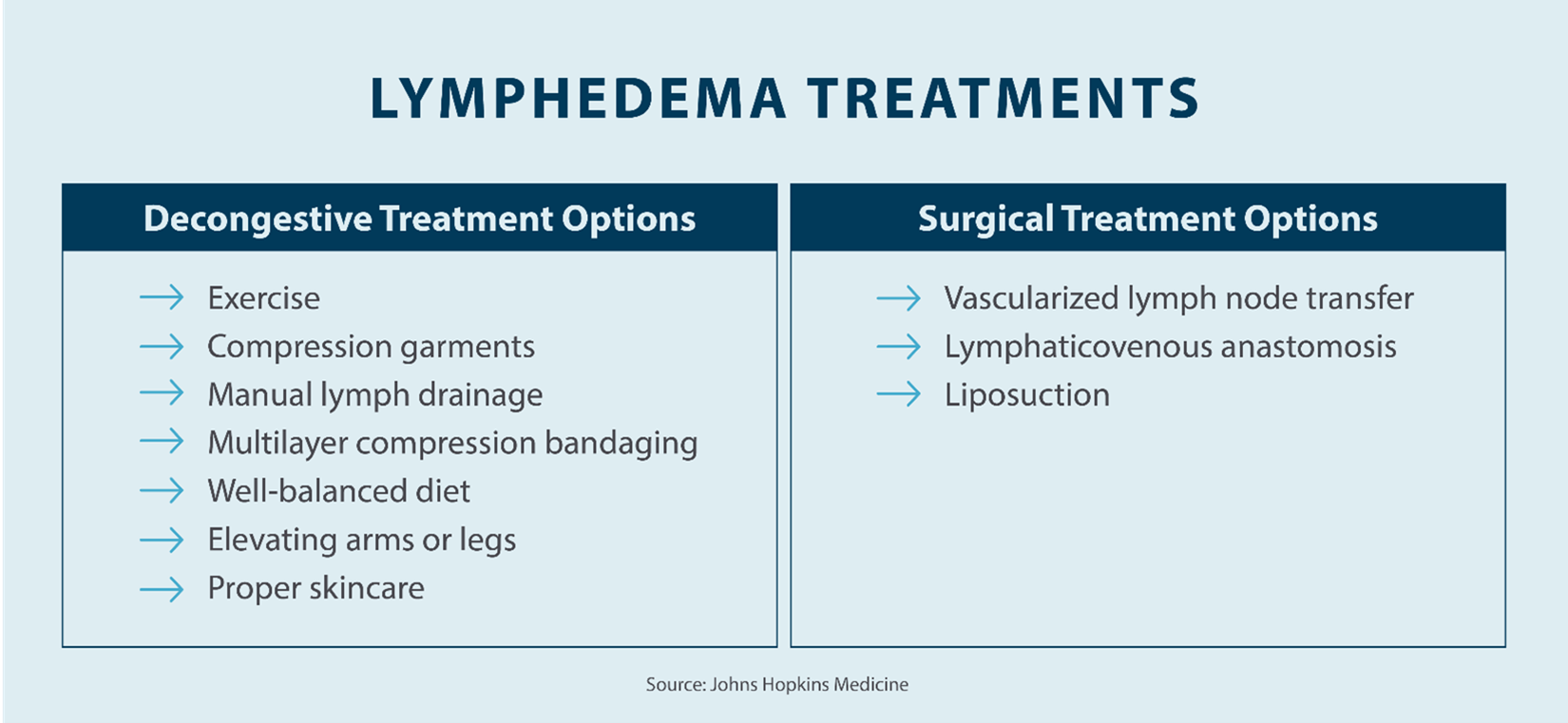
In addition to the above treatment methods, there are various other ways to treat lymphedema at home, such as with Tactile Medical’s lymphedema pumps. Tactile Medical’s lymphedema treatment recommendations include following a prescribed treatment with your pump to reduce swelling and encourage the flow of lymph fluid. Tactile Medical has compression pumps for every area of the body, including the upper body, lower body, and head and neck.
If you have swelling in your lower body, upper body, or your head and neck, Tactile Medical’s pneumatic compression device gently assists in the drainage of excess fluid through a dynamic work and release action.
Lymphedema is a life-long disease, but in most cases, it’s not life-threatening as long as you take the right steps to treat it. Consult with your doctor to determine the best treatment options for you. At Tactile Medical, our lymphedema pumps can be prescribed by your doctor and don’t involve the need for medications or surgery.
If you notice any swelling in your arm or leg, it may be a sign of lymphedema. If left untreated, it can lead to more serious health concerns, such as pain, discomfort, and infection, which is why seeking help from a doctor or lymphedema specialist is important.
Lymphedema is swelling that’s caused by an accumulation of lymph fluid in your body. It can affect any part of your body, and the swelling can happen immediately or over time. The swelling can be painful and uncomfortable and can make doing your daily tasks more difficult. With lymphedema, doing something as simple as getting up in the morning to go to work can become a challenge.
Fortunately, there are many ways you can treat and manage lymphedema. If you’re in the beginning stages, making simple healthy lifestyle changes and keeping the affected area elevated can help to relieve symptoms. Maintenance therapy solutions, such as Tactile Medical’s lymphedema products, the Flexitouch Plus System and Nimbl System, can assist in the home management of lymphedema symptoms like chronic swelling and venous ulcers. In later stages, surgery may be recommended to reduce swelling and encourage the flow of lymph fluid. The type of treatment you’ll need depends on the severity of your swelling.
Tactile Medical provides pneumatic compression pumps that can be used to treat lymphedema symptoms right at home. We offer garments to use with the pump for the upper body, lower body, and head and neck. No matter where your swelling is, Tactile has a solution for you so you can reduce your swelling and go back to living a healthy and happy life.
Living with lymphedema while trying to manage your weight can feel overwhelming, but understanding the connection between lymphedema and weight loss can help you develop effective strategies for both conditions.
Read More
Stage three lymphedema is the most advanced stage of this chronic condition. In this stage, the affected body part might display one or more symptoms, such as significant swelling, alterations in the skin, or recurring episodes of infection. While this stage can be challenging to manage, understanding your condition and...
Read More
When the lymphatic system becomes compromised, fluid buildup can lead to stage 1 lymphedema, a condition marked by mild but noticeable swelling in affected areas. This initial stage is a crucial window for intervention, as proper treatment can prevent progression to more severe stages. Knowing the signs, causes, and treatment...
Read More
Living with stage 2 lymphedema brings unique challenges, but understanding your condition is the first step toward effectively managing it. While this stage marks a point where the condition becomes irreversible, there are many ways to maintain your quality of life and prevent symptoms from progressing. Keep reading to explore...
Read More
Call us at 1.800.575.1900